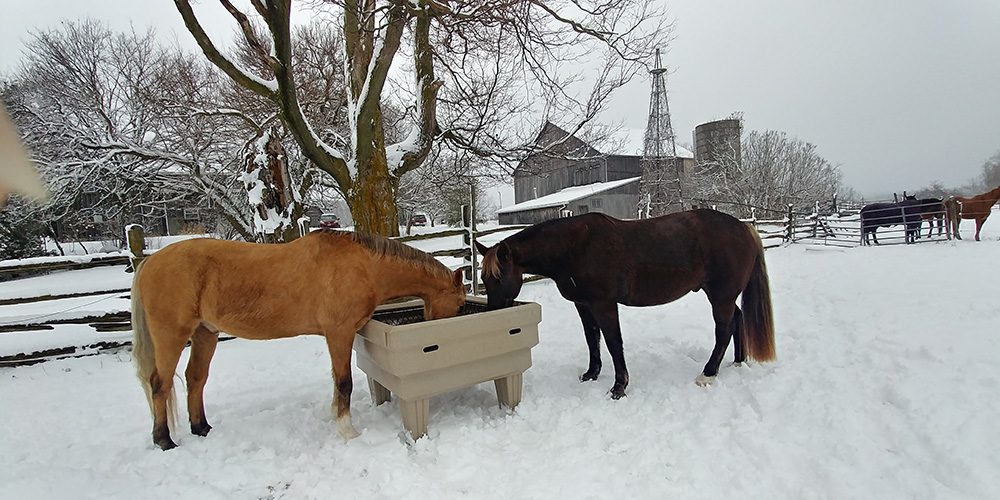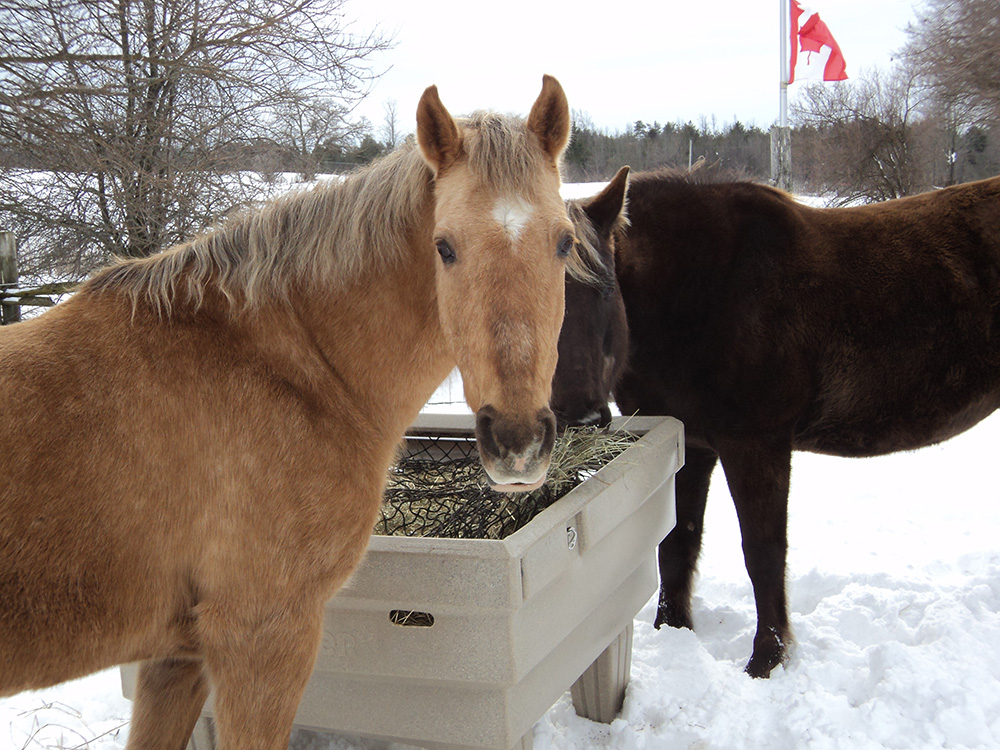
The experts agree that horses should have hay available all the time, as long as consumption is moderated.*
By Sue Wilson.
Getting home late from work and seeing their horses pacing the fence was always stressful for Carol and Barry. Their seven horses live outside most of the time in three paddocks at their hobby farm near Uxbridge. Fresh hay was fed every morning and evening, but often the horses would gobble or partially waste their ration, and then they would be hungry and impatient by their next feeding. This all started to change when Carol and Barry got their first hay OptiMizer in November.
Our journey to develop the OptiMizer started about a decade ago with our small herd at our farm near Guelph. We strive to keep our horses in a safe, natural environment, and making sure they always have access to forage is part of that.
Horses have evolved over time to consume small amounts of forage throughout the day and night, spending 10 to 17 hours grazing during 15 to 20 grazing periods. Since our grazing season in Ontario is limited, we rely on hay for many months of the year. But trying to simulate natural grazing with hay can be challenging. We quickly learned that when forage was unrestricted, a lot of it was wasted and our easy-keeping rocky mountain horses grew obese. We tried a number of systems to reduce waste and moderate consumption, learning along the way that solutions had to be practical and, above all, safe for our horses.
The experts agree that horses should have hay available all the time, as long as consumption is moderated.*
 We started with slow feeding hay bags and through trial and error found that high-strength knotless nylon nets not only lasted a long time but were gentle on the horses’ lips and teeth. But they weren’t without their challenges. They worked well when we hung them low to the ground, but when one of our horses was shod, we had to hang them unnaturally high up. It also took a long time to collect, fill, and re-hang all of them—well over an hour each day in the winter for our eight horses.
We started with slow feeding hay bags and through trial and error found that high-strength knotless nylon nets not only lasted a long time but were gentle on the horses’ lips and teeth. But they weren’t without their challenges. They worked well when we hung them low to the ground, but when one of our horses was shod, we had to hang them unnaturally high up. It also took a long time to collect, fill, and re-hang all of them—well over an hour each day in the winter for our eight horses.
We also used first-generation hay OptiMizers. These feeders were invented in 2004 by Matthew Bulmer, a hay farmer near Guelph. They were designed to hold two small square bales of hay with a screen that floated down as the horses ate. They were easy and fast to load, helped to reduce waste, allowed the horses to eat in a natural head-down position and were made from sturdy galvanized steel. But while we found the 6” grill metered their hay consumption to a degree, it wasn’t enough.
In 2018, I started to work with Matthew to develop a new OptiMizer that would extend the time our horses grazed at the feeder. Carefully considering our requirements, Matthew built four prototypes which we tested and kept improving based on feedback from the users (horse and human). Three key breakthroughs in these early days were:
1. Making the body of the feeder with rotomoulded plastic. This made it possible to round and bevel all the corners on the new OptiMizer. The plastic chosen is the same used to make playground equipment, so it is super safe, durable, temperature and UV resistant. It is also lightweight, so we can easily transport and reposition the OptiMizer around our paddocks.
2. Designing a net operating assembly that worked in any terrain and making it out of stainless steel. This created a really quick and easy way to open and close the feeder for reloading.
3. Canadian knotless slow feed netting provided superior performance. We tried several sources of knotless nylon nets (Canadian, Asian), and tested 2”, 1 ½ “ and 1 ¼” netting. The integrity of the Canadian sourced nets was superior - with no holes in 18 months and counting!
 During prototype testing, we braided a GPS into the tail of our alpha horse and monitored his position every minute for over 1,000 hours. We studied his location in our barn and paddocks versus time of day and weather conditions. Among other things, this data helped us choose the 2” netting for our horses to simulate the best quality of grazing time. We also measured our hay consumption and conservatively estimated that the prototypes saved 150 bales of hay over six months. Hay savings were due to less waste (hanging hay bags results in some waste under the bags) and less overeating from the first generation hay OptiMizers.
During prototype testing, we braided a GPS into the tail of our alpha horse and monitored his position every minute for over 1,000 hours. We studied his location in our barn and paddocks versus time of day and weather conditions. Among other things, this data helped us choose the 2” netting for our horses to simulate the best quality of grazing time. We also measured our hay consumption and conservatively estimated that the prototypes saved 150 bales of hay over six months. Hay savings were due to less waste (hanging hay bags results in some waste under the bags) and less overeating from the first generation hay OptiMizers.
At our routine vet check in April 2019, our veterinarian concluded that our horses had their best winter ever. Our easy keepers were not (too) fat and our hard keepers (including a 17 year old, off-the-track thoroughbred) were in excellent condition. That was the final verification we needed, and so we decided to commercialize the next generation OptiMizer. Our target was to introduce the product at the Royal Agricultural Winter Fair in Toronto in November 2019.
Fast forward seven months, and the new OptiMizer was front and centre in System Equine’s booth at the Royal. And that is where Carol and Barry come back into this story. I happened to be at the booth when they visited. After discussions with me, System Equine, and our manufacturer in Newmarket, they decided to try an OptiMizer. After the first big snowstorm in December, they were hooked and bought an OptiMizer for each of their paddocks. On January 19, 2020 I received this lovely email from Carol:
“So pleased with the hay optimizer that after buying our first one, we decided to buy two more. I love the fact that the horses are so content. They no longer pace the fence waiting for their hay. I feel calmer too as I don’t have to race home from work to get their evening hay out. I also love the convenience of being able to put two bales of hay in at a time. The horses slowly eat their hay through the soft netting and there is no waste! Thank you for designing such a great product.”
This winter has been pretty easy for feeding hay at our farm near Guelph. Our herd is now six horses, of which three are easy keepers and three are hard keepers. We use two OptiMizers and feed hay once a day in a fraction of the time it used to take to fill hay bags. And the horses? They all look and feel great.
To learn more about our story and the OptiMizer, please visit our website at www.hayoptimizer.net. OptiMizers are available for sale at several fine retailers in Ontario.
Sue Wilson Founder, Wishing Well Services Ltd.
*survey of attendees at the International Symposium of Equitation Science, University of Guelph, August 2019. 82% of respondents strongly agreed or agreed to “Horses should have access, all the time, to free-choice hay as long as consumption is restricted (e.g. hay nets or slow feeders).”


